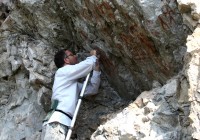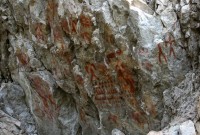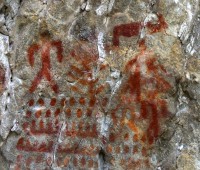 Archaeologists have finally tracked down prehistoric petrographs that were rumored to exist in a remote area of southeastern Russia. Locals have long whispered of ancient rock art in the craggy mountains of the Shilka River basin in the Transbaikal region, but nobody knew the exact location. Local legend has it that the petrographs were first discovered by a hunter many a years ago. He left his hometown and was never heard from again. More recently, a teacher from a village on the Shilka River was reputed to have taken her students to see the rock art in the 1990s. She died before archaeologists began looking.
Archaeologists have finally tracked down prehistoric petrographs that were rumored to exist in a remote area of southeastern Russia. Locals have long whispered of ancient rock art in the craggy mountains of the Shilka River basin in the Transbaikal region, but nobody knew the exact location. Local legend has it that the petrographs were first discovered by a hunter many a years ago. He left his hometown and was never heard from again. More recently, a teacher from a village on the Shilka River was reputed to have taken her students to see the rock art in the 1990s. She died before archaeologists began looking.
In 2013, a team of archaeologists from Novosibirsk State University and the Institute of Archeology and Ethnography decided to explore the mountainous region in search of the petrographs. Local man Evgeny Karelin served as a guide to the area even though he didn’t know where the rock art was either. Then the archaeologists, led by associate professor Sergey Alkin, searched until they found the petrographs on a craggy rock face overlooking the Largi River at the end of summer.
 It was truly a last-minute find. The field season was coming to a rapid close so the archaeologists only had one hour to study the rock art. They returned the next year and again in 2015, thoroughly examining and documenting the petrographs. They made a complete copy of all the art work and took samples of the pigment.
It was truly a last-minute find. The field season was coming to a rapid close so the archaeologists only had one hour to study the rock art. They returned the next year and again in 2015, thoroughly examining and documenting the petrographs. They made a complete copy of all the art work and took samples of the pigment.
Now that they’ve found it, archaeologists are not disappointed. It’s quite a large piece with multiple figures painted on the rocky surface with red and ochre pigments. The condition is excellent, thanks in part to its remote location keeping people from messing with it. Other petrographs found in the area are much smaller and more worn. There are more than 20 elements, most of them human figures, plus an animal with hoofs, a tree, what may be birds and geometric shapes.
“Of course, interpretation of the images is disputable. Some elements can be explained only through archaeological and ethnographic analogues. Even the human figures can be interpreted as hunters, spirits or somebody else. For instance, one figure has a circle nearby, which should be a solar sign. With a cross inside, this circle is likely to represent a shaman’s drum, which is typical for many Siberian cultures. Thus, we may assume that this figure shows a shaman with a drum.”
[Sergey Alkin] is quite sure about distinguishing a hoofed animal, presumably a bull. Other distinct elements show some birds. Bird images are typical for other known petrographs in Transbaikalia. An important part of the Largi petrograph is numerous points and lines. “Such points can be interpreted as a symbol of counting with the painter fixing the number of some objects (say, cattle). As for the vertical lines above a horizontal one, this could be a long boat with people sitting in it. Archaeologists often identify similar images from other regions in such a way; however, in Eastern Transbaikalia it is the only known image of this type,” says the scientist.
 While other petrographs in the region often are accompanied by ledges underneath the drawings that bear artifacts — tools, arrowheads — which archaeologists believe were part of a ritual sacrifice, there is no ledge here, and no evidence of religious activity. A nearby site at the mouth of the Largi river which was used by hunters and fisherman in the Bronze Age has a large number of pottery fragments and ceramic vessels. The team hopes to do more comparative studies to see if there may be a link between the new find at the site at the mouth of the river.
While other petrographs in the region often are accompanied by ledges underneath the drawings that bear artifacts — tools, arrowheads — which archaeologists believe were part of a ritual sacrifice, there is no ledge here, and no evidence of religious activity. A nearby site at the mouth of the Largi river which was used by hunters and fisherman in the Bronze Age has a large number of pottery fragments and ceramic vessels. The team hopes to do more comparative studies to see if there may be a link between the new find at the site at the mouth of the river.
Comparison with other rock art in the Eastern Transbaikal and Yakutia regions indicates the petrographs were made about 4,000 years ago during the Bronze Age. Now the team will study samples and the detailed copy to learn more about the imagery and arrangement of the figures. They deliberately kept the discovery to themselves to ensure they had all the time they needed to make the copy and to keep the site free of interference from tourists and other researchers. They won’t be releasing the exact location of find site to the public anytime soon and it’s enough of a challenge to get there that archaeologists think the rock art will remain pristine.